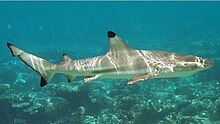Blacktip reef sharks
| Blacktip reef shark | |
|---|---|
 |
|
| Scientific classification | |
| Kingdom: | Animalia |
| Phylum: | Chordata |
| Class: | Chondrichthyes |
| Order: | Carcharhiniformes |
| Family: | Carcharhinidae |
| Genus: | Carcharhinus |
| Species: | C. melanopterus |
| Binomial name | |
|
Carcharhinus melanopterus (Quoy & Gaimard, 1824) |
|
 |
|
| Range of the blacktip reef shark | |
| Synonyms | |
|
Carcharias elegans Ehrenberg, 1871 * ambiguous synonym |
|
Carcharias elegans Ehrenberg, 1871
Carcharias marianensis Engelhardt, 1912
Carcharias melanopterus Quoy & Gaimard, 1824
Carcharias playfairii Günther, 1870
Squalus carcharias minor Forsskål, 1775
Squalus commersonii* Blainville, 1816
Squalus ustus* Duméril, 1824
* ambiguous synonym
The blacktip reef shark (Carcharhinus melanopterus) is a species of requiem shark, in the family Carcharhinidae, easily identified by the prominent black tips on its fins (especially on the first dorsal fin and its caudal fin). Among the most abundant sharks inhabiting the tropical coral reefs of the Indian and Pacific Oceans, this species prefers shallow, inshore waters. Its exposed first dorsal fin is a common sight in the region. Most blacktip reef sharks are found over reef ledges and sandy flats, though they have also been known to enter brackish and freshwater environments. This species typically attains a length of 1.6 m (5.2 ft).
Blacktip reef sharks have extremely small home ranges and exhibit strong site fidelity, remaining within the same local area for up to several years at a time. They are active predators of small bony fishes, cephalopods, and crustaceans, and have also been known to feed on sea snakes and seabirds. Accounts of the blacktip reef shark's life history have been variable and sometimes contradictory, in part reflecting geographical differences within the species. Like other members of its family, this shark is viviparous, with females giving birth to two to five young on a biennial, annual, or possibly biannual cycle. Reports of the gestation period range from 7–9, through 10–11, to possibly 16 months. Mating is preceded by the male following closely behind the female, likely attracted by her chemical signals. Newborn sharks are found further inshore and in shallower water than adults, frequently roaming in large groups over areas flooded by high tide.
...
Wikipedia

